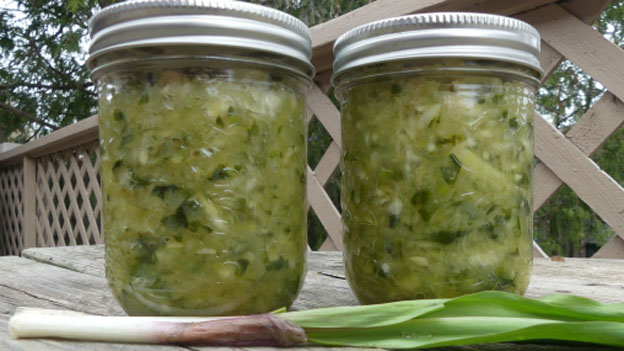






Ingredients
>> 4 cups finely grated green cabbage (about 1 small head of cabbage)
>> 1 1/2 to 2 tsp sea salt (to taste)
>> 3 1/2 cups shredded ramp leaves and bulbs (wild leeks)
>> 4 to 6 cloves garlic (minced)
Instructions
Sterilize the jars you will be using. It is extremely important that everything is sterilized to allow for proper fermentation.
Place the grated cabbage in a large mixing bowl and top with 1 1/2 teaspoons sea salt. Wash hands thoroughly and massage cabbage for ten minutes. The cabbage should start softening, shrinking in size, and releasing water. Continue massaging until this happens.
Add remaining ingredients and massage once more with clean hands for 5 minutes until thoroughly combined. Taste test and adjust flavour, adding more salt for saltiness. Add more garlic if desired.
Use your clean hands to put the sauerkraut mixture into your sterilized jars (that are at room temperature) and press down firmly to pack. There should be enough liquid from the massaging to rise up and cover the vegetables. If this does not happen, top with filtered (or distilled) water until covered. Make sure all the vegetable matter remains below the liquid level by using a fermentation weight. If this is not available to you then tuck a cabbage leaf over the top of the prepared vegetables. Place a ramekin, or something similar on the leaf.(Some people will fill a plastic bag with water to use as a weight but this should be a last resort method only.)
Be sure there is plenty of room (about 1 1/2") between the contents and the lid so it has room to expand. Seal with a lid and set on the counter where there is no direct sun exposure or in a cabinet. The ideal temperature for fermentation is above 65 degrees F (18 C), so be sure to keep your environment on the warmer side to encourage proper fermentation.
Fermentation can happen as quickly as 24 hours if your space is really warm, or it can take as long as 2 weeks(again, depending on the room temperature).
If you are not using jars that have an airlock, then during the fermentation process, open the jars once a day to release air (you should feel pressure release and see air bubbles when you open the jars). Press down with a sterilized object such as a spoon or the bottom of a drinking glass to ensure that the vegetables are still completely covered in the liquid.
The longer it sits and ferments, the tangier the flavour. Sample occasionally with a clean utensil to test and see if it is at the right stage for you. Once it has reached the desired tanginess, cover securely and transfer to the fridge, where it should keep at least 3 months. Be sure to write the competion date on your jars!
Important Tip: If using jars that do not have an airlock, failure to release pressure on a daily basis can result in the jar breaking.
Wild Edibles in Recipe: Wild Leek
Wild Fungi in Recipe:
Edible Trees and Shrubs in Recipe:
Recipe Category: Fermented Wild Foods
Winter Survival Food Handbook

PDF Plant Magazines
Types of Wild Food
Geographic Zones Seasons
Disclaimer
EdibleWildFood.com is informational in nature. While we strive to be 100% accurate, it is solely up to the reader to ensure proper plant identification. Some wild plants are poisonous or can have serious adverse health effects.
We are not health professionals, medical doctors, nor are we nutritionists. It is up to the reader to verify nutritional information and health benefits with qualified professionals for all edible plants listed in this web site. Please click here for more information.
Why Edible Wild Food?
- Food costs are rising
- Free, wild food is readily abundant
- Wild food adds nutrition to your diet
- Wild food can help treat various medical conditions





